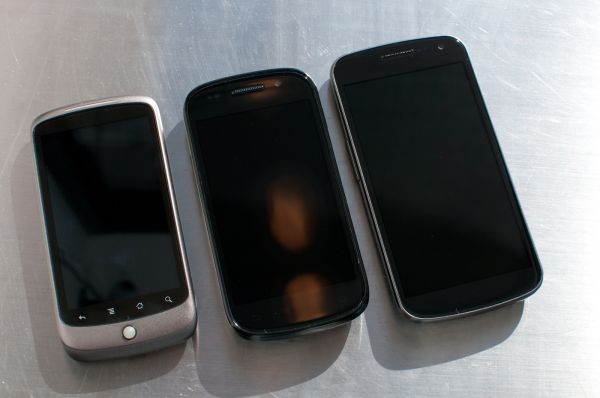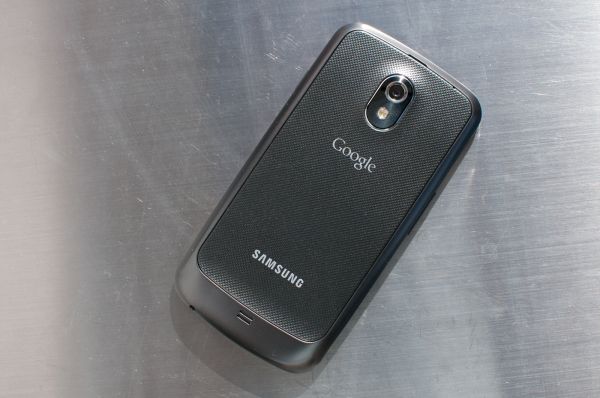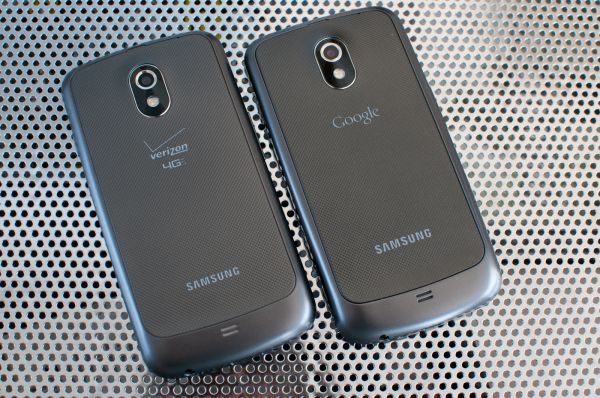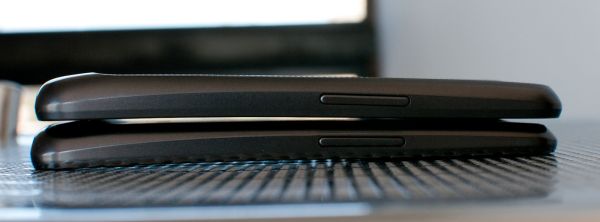Samsung Galaxy Nexus & Ice Cream Sandwich Review
by Brian Klug & Anand Lal Shimpi on January 18, 2012 1:34 PM ESTThe Galaxy Nexus - Hardware and Aesthetics
The evolution of Google’s Nexus line is an interesting one. Each year, Google choses both a silicon partner and an OEM to make a unique hardware archetype which it caters a specific build of Android to. We’ve now seen three Nexus handset designs from two OEMs and three silicon vendors - the Nexus One (HTC and Qualcomm’s QSD8x50), Nexus S (Samsung and Samsung’s S5PC110 ‘Hummingbird’), and today the Galaxy Nexus (Samsung and TI’s OMAP4460).
Looking at the hardware of those three handsets gives a great survey of the course the Android ecosystem has taken over the last couple of years. The Nexus One started things out with a 3.7” LCD, capacitive buttons, and hardware trackball. Nexus S then removed the trackball, added a curved 4.0” display, and ditched the microSD card slot. The Galaxy Nexus continues in that direction, increasing display size to 4.65” and resolution to 1280x720, and finally removing the capacitive buttons all together. Instead, the Galaxy Nexus uses a 96 x 720 region at the bottom of the display to visualize the navigational buttons, a move that has the consequence of also keeping the display interaction area aspect ratio close to that of WVGA.
It’s interesting to see how many of the design motifs set by the original Nexus One still have been thoughtfully preserved on the Galaxy Nexus. The notched chrome ring around the camera aperture has continued as a thread for three generations, as has the overall lightly rounded shape. The Galaxy Nexus also retains the chin from Nexus S backside where the speakerphone port and primary cellular antennas are located. In addition, the volume rocker, power/lock button, headphone jack, and primary microphone position from the Nexus S is unchanged.
The Galaxy Nexus’ backside is no longer the extremely slippery and scratch prone plastic that the Nexus S (and original Galaxy S) adorned, instead it’s a textured, lightly soft touch material. I’m always surprised by how much of a difference changing the backside texture makes on the overall in-hand feel impressions I come away with, and in this case it’s a major positive change. It’s clear that this is an evolution of Nexus more than a huge departure from what’s come before - if anything the Galaxy Nexus is like a larger, thinner, more refined Nexus S.
We’ve taken a look at both the CDMA/LTE (codename mysid/toro) and the GSM/UMTS (codename yakju/maguro) Galaxy Nexus variants.
The two differ beyond just the air interfaces they support slightly in the physical department as well, though the two share all the same other features (SoC, display, camera, etc.). The CDMA/LTE Galaxy Nexus is ever so slightly thicker than the GSM/UMTS Galaxy Nexus, though the difference is enough to be perceptible.
In addition, the two have the same exterior “titanium silver” color, no doubt the differences we saw earlier can be attributed to the difference between renders and the real deal. The other small detail is that the two use very different, non-interchangeable batteries - the GSM/UMTS variant uses a 6.48 Whr battery, the CDMA/LTE version gets a slightly larger 6.85 Whr battery. Both of these include the NFC antenna patterned the outside surface of the battery, just under the sticker.
Other than those subtle differences, Samsung has done a good job masking the challenges which underlie having two superficially similar phones with different cellular architectures. The two variants do feel different in the hand, but the difference isn't dramatic.
| Physical Comparison | ||||
| Apple iPhone 4S | Samsung Galaxy S 2 | Samsung Galaxy Nexus (CDMA/LTE) | Samsung Galaxy Nexus (GSM/UMTS) | |
| Height | 115.2 mm (4.5") | 125.3 mm (4.93") | 135.5 mm (5.33") | 135.5 mm (5.33") |
| Width | 58.6 mm (2.31") | 66.1 mm (2.60") | 67.94 mm (2.67) | 67.94 mm (2.67) |
| Depth | 9.3 mm ( 0.37") | 8.49 mm (0.33") | 9.47 mm (0.37") | 8.94 mm (0.35") |
| Weight | 140 g (4.9 oz) | 115 g (4.06 oz) | 150 g (5.3 oz) | 135 g (4.8 oz) |
| CPU | Apple A5 @ ~800MHz Dual Core Cortex A9 | 1.2 GHz Exynos 4210 Dual Core Cortex A9 | 1.2 GHz Dual Core Cortex-A9 OMAP 4460 | 1.2 GHz Dual Core Cortex-A9 OMAP 4460 |
| GPU | PowerVR SGX 543MP2 | ARM Mali-400 | PowerVR SGX 540 | PowerVR SGX 540 |
| RAM | 512MB LPDDR2-800 | 1 GB LPDDR2 | 1 GB LPDDR2 | 1 GB LPDDR2 |
| NAND | 16GB, 32GB or 64GB integrated | 16 GB NAND with up to 32 GB microSD | 32 GB NAND | 16/32 GB NAND |
| Camera | 8 MP with LED Flash + Front Facing Camera | 8 MP AF/LED flash, 2 MP front facing | 5 MP with AF/LED Flash, 1080p30 video recording, 1.3 MP front facing | 5 MP with AF/LED Flash, 1080p30 video recording, 1.3 MP front facing |
| Screen | 3.5" 640 x 960 LED backlit LCD | 4.27" 800 x 480 SAMOLED+ | 4.65" 1280x720 SAMOLED HD | 4.65" 1280x720 SAMOLED HD |
| Battery | Internal 5.3 Whr | Removable 6.11 Whr | Removable 6.85 Whr | Removable 6.48 Whr |






















185 Comments
View All Comments
TedG - Wednesday, January 18, 2012 - link
I am looking forward to ICS on my RAZR. It seems similar in power and size to the Nexus.Jonathan Dum - Wednesday, January 18, 2012 - link
Any comments on the quality of the touch sensors? My biggest gripe with my Nexus One is the absolutely inane touch accuracy in comparison to an iPhone. If these new ICS phones have significantly improved touch sensors, I may be coaxed into sticking with Android.jalexoid - Wednesday, January 18, 2012 - link
Synaptics touchscreen controller on N1 was to blame. Even the HTC's "copy" Desire had a much better touchscreen experience due to a better touchscreen controller.All devices after that should have a really good controller.
tipoo - Thursday, January 19, 2012 - link
Same with my Nexus S. The locational accuracy is good, but it actually senses a tap with my finger a few millimeters above the screen, which can cause problems with the keyboard and other precise apps.Brian Klug - Thursday, January 19, 2012 - link
That was always my bug with the Nexus One as well, and it remains an unsolved problem to this day on that phone.I've seen no touch recognitions at all on the Galaxy Nexus. For the most part honestly these issues have gone away as the OEMs stopped being cheap with their capacitive layers and controllers. The Nexus One was especially bad.
I've seen some people complaining about issues with recognition in the bottom right corner - hardware swaps fix those problems.
-Brian
Skiddywinks - Wednesday, January 18, 2012 - link
... is the GN still going to be the best Android on the market? I upgrade in March, and it basically comes down to the S2 or the GN. Each has their advantages, but personally it largely comes down to the display and the GPU.I like to play emulated games on my phone, but I don't know how they work in terms of whether they are software only, or can GPU accelerate. The better GPU in the S2 doesn't really do much if the GN can play everything else on the market at no apparent deficit. Better display all the way in that case. GN wins.
I'm not liking the lack of mSD in the GN either, though.
BAH. Decisions, decisions.
tipoo - Thursday, January 19, 2012 - link
Yeah, the Mali 400 in the GS2 might benchmark way higher than the Galaxy Nexus, but there are no games that exclusively run on it, or even that have more features on it like Tegra phones. I'd guess that even with its relatively weak GPU the Galaxy Nexus will never leave you wanting in games for the next year or two, and its screen is better. My Nexus S can still play top end games like Shadowgun, and that was built for more powerful tablets. With Android developers aim for middling hardware.medi01 - Wednesday, January 18, 2012 - link
@Android is an OS that, although more closed than many would like, still allows more flexibility than iOS@And that comparing Open Source OS to something as closed as it gets. It is merely "still allows more than iOS", hilarious.
doobydoo - Thursday, January 19, 2012 - link
The openness of Android wasn't being compared to iOS, the flexibility was.Two separate points.
Gwynbleidd - Wednesday, January 18, 2012 - link
Two things, though:1. You wrote "Business is as usual for Windows users as ICS based devices just appear as a drive letter thanks to native MTP support." - that's not true, because of MTP Nexus appears in My Computer in Windows as a multimedia device and does not have a letter assigned, so sadly it's not possible to use traditional file managers like Total Commander to deal with files on it without additional plugins.
2. Did you notice any screen quality issues in your devices? Mine shows ugly pinkish smudges visibly especially on gray backgrounds, here's photo (it's out of focus on purpose, otherwise there would be a rainbow goo on screen):
http://img812.imageshack.us/img812/7794/nexussmudg...
So when scrolling webpages you can see that text is pinkish at the top, then white stripe, then pinkish again... Apparently I'm not the only one having this issue with Nexus, and there is a long thread on xda forum about the same problem with Galaxy Note Screens
http://forum.xda-developers.com/showthread.php?t=1...
A little investigation, maybe? ;)